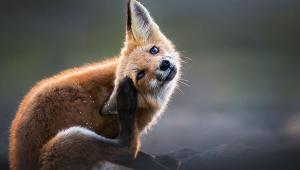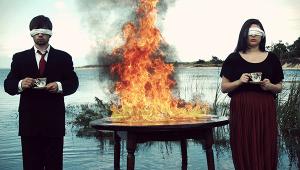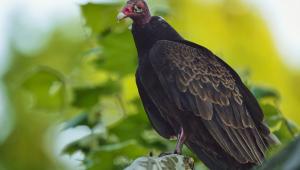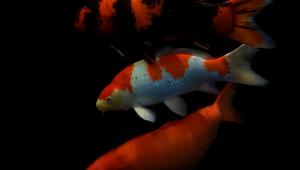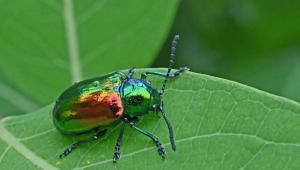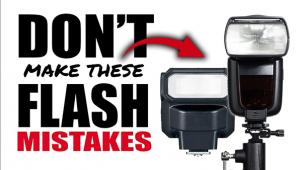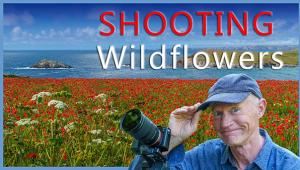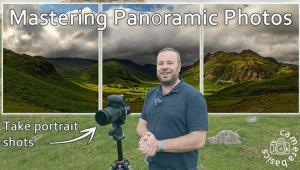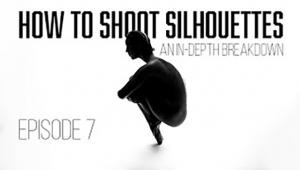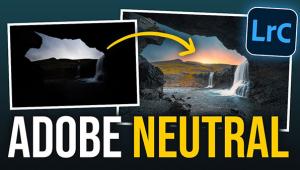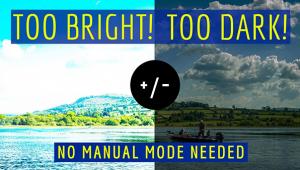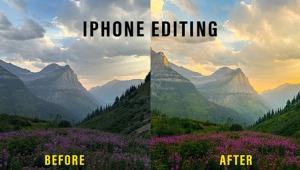Photography Goes Underground: The Cave Photography Of Peter Gedei
Caving,” “spelunking,” “potholing.” Whatever you call it, this subterranean activity is not for everyone. There’s even a phobia that keeps some out of caves—speluncaphobia. Then, of course, there’s fear of darkness (achluophobia) and the rather more common claustrophobia—fear of no escape from small or enclosed spaces.
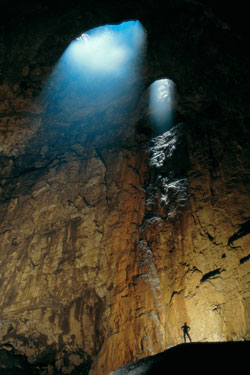
Peter Gedei had taken the picture of the entrance hall several times before, but had never been lucky enough to see it in clear air. In this picture, the human figure is crucial to sense the cave’s large scale. This picture won first prize out of 8500 entries in a Slovenian national photo competition. Technical info: Olympus OM-4Ti, Zuiko 28mm f/2.0 at f/5.6, 10 seconds, Fuji Provia 100F, lit with a Metz 60 from the left and a Metz 45 as backlight behind the caver.
All Photos © Peter Gedei
Phobias not withstanding, humankind has always been fascinated by caves—by the underworld. Some 30,000 years ago, our ancestors used cave walls as canvases on which to paint images of their world. Perhaps the most famous is art in the Lascaux Caves in Southern France—detailed and anatomically correct images of wild horses, woolly mammoths, lions, antelope, and bison. Archeologists surmise that the drawings were made to capture the spirits of the animals they hunted—to make them easier to kill.
Many Native American creation stories tell of ancestors ascending from the underground, while Plato and, much more recently, mega-group Mumford & Sons both used “The Cave” in allegories aimed at understanding or coping with reality.

This cave was discovered four years ago and was one of the major Slovenian cave discoveries that year. Beside big pits and large ornamented halls, it has interesting structural formations. During his exploration, Gedei was fascinated by a small helictite that reminded him of a bird. “It was very difficult to approach and frame. This macro shot was lit with only one flash held by my assistant.” Technical info: Nikon D90, 24-85mm f/3.5-4.5 at 85mm, f/16, 1/50 sec, ISO 200.
170 Days Underground
Phobias and philosophical ramblings, however, probably have little to do with Peter Gedei’s long-running fascination with caves. Gedei is an experienced caver and photographer from Ljubljana, Slovenia. With 500 cave explorations over the past 26 years to his credit, Gedei calculates he has spent more than 170 days underground.
Above ground he works as a designer at the computer monthly magazine Monitor and is co-founder of Place3D—a company specializing in 3D stereo photography and video projects. He also edits the Slovenian cave magazine Jamar.
“Many people fear caves, feeling they are not safe,” Gedei said. “But, for me, that fear receded on my first visit. It’s been the same with many others I’ve taken into a cave for the first time. Despite their initial fear of enclosed spaces and the dark, they usually loosen up after a few meters. By the end of the tour, they are impressed and want to do it again.
“As my interest in caves evolved, I was mostly devoted to exploring. But soon I wanted to immortalize my cave visits. Because photographing caves presents unique challenges, I had years of experimentation in front of me. Those, of course, were the days of film and before Internet access to literature or the work of others. But I think this long development time provided a solid education for me, one that is hard to repeat by today’s photographers for whom these new technologies are readily available.”
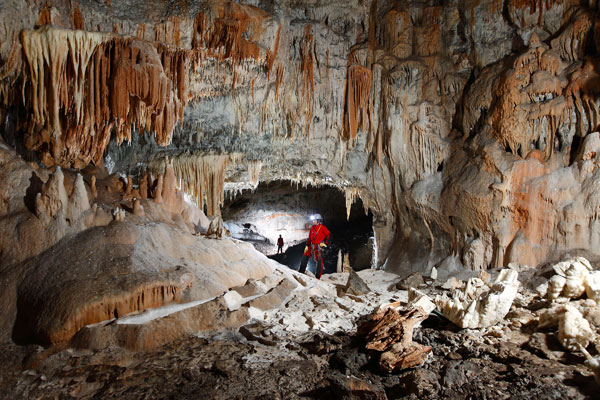
There are several caves in Slovenia that provided shelter for prehistoric people. In this cave, explorers recently found several drawings—the first discovery of prehistoric art in Slovenia. The cave is now locked to preserve the drawings. This image shows the beautifully ornamented last hall using four light sources. The shot was challenging because of difficult footing. Technical info: Canon 5D Mark II, 16-35mm f/2.8 at 21mm, f/5.6, 1 second, ISO 400.
What Gedei Has Learned
“The cave is ruled by complete darkness. So the cave space is a natural studio that needs to be lit. This is, of course, the biggest challenge for any cave photographer. The lights we take into caves these days are very strong, so setting up the shot is not that difficult anymore.
“Good cave photographers know how to orient themselves in the space and decide quickly about lighting. Usually, little time is needed to set up a simple shot. More complex images might require up to an hour.
“An individual photographer can well be hampered by conditions in the cave—humidity, tight spaces, mud, and, of course, darkness. So helpers—without whom cave photography usually cannot happen—are important. Fellow cavers can help carry equipment and set up lighting. Companions also serve as models. Human figures provide scale in what sometimes are huge spaces. It’s the photographer’s job to position and pose the model or models appropriately.
“Overall, I think that the most important thing in cave photography is developing a good sense of space. Everything else—how to distribute the lighting and models—is more routine. In the beginning, for me, there was a lot of experimentation and repetition to achieve the best results. Luckily, conditions in caves are always the same, so there could be infinite repeats. But that, of course, is not my goal. It has always been a challenge for me to visit a completely unknown cave and make as many successful shots as possible to tell its story,” Gedei said.

There are several famous caves in Southern France with rare aragonites of blue and citrus-yellow. “To get these images, the team and I had to get through several tunnels, abysses, and shafts. The round trip was nine hours with about an hour for the shoot. The yellow color of the aragonites could only be shot at a certain angle since they are white when lit frontally.” Technical info: Canon 5D Mark II, 16-35mm f/2.8 at 24mm, f/8.0, 1/50 sec, ISO 200.
Don’t Jump Right In
Gedei believes that people interested in cave photography must first master the art of caving—or put themselves in the hands of an accomplished caver. “With proper preparation and supervision, caving tours usually pass without complications. Generally speaking, there are very few accidents. When they do happen, it’s the result of carelessness and human error. I have never been harmed myself—with the exception of an occasional bruise or a scratch,” Gedei said.
Physical fitness is also a prerequisite. Gedei says that caving can be very physically demanding, depending on the type of cave being explored. Some caves are short and not very deep, but others require climbing and/or rappelling and one can grow tired very quickly. Then, too, there’s usually lots of equipment to lug around—particularly if photography is the goal. Gedei estimates that his photo equipment runs around 18 lbs to which must be added caving gear, rigging, food, and drink.

Responsible cavers and cave photographers respect and protect the cave environment. “Caves are usually damaged by humans and I’m afraid cave photographers—by photographing these wonders of nature—bear some of the blame by exposing their beauty and mystery. Are my photos a silent invitation to others to visit a cave and, with their entry, cause damage to these delicate environments? That is why I prefer to keep some cave names secret.” Technical info: Canon 5D Mark II, 16-35mm f/2.8 at 24mm, f/5.6, 1/50 sec, ISO 400.
ToolBox
“In the early days, the first camera that really suited me was the Olympus OM-2 SP, which was, in a few years time, joined by an OM-4Ti. They remained faithful all the way to my last analog shots. I took all photos with two lenses—Zuiko 28mm f/2.0 and 21mm f/2.0—while using mostly Fuji Provia 100, Velvia and some Kodak.
“I let myself have more freedom with the choice of the flash. Usually, I chose manual and robust flashes. I had the best results with the Metz 45 and 60. In bigger spaces I also used flashbulbs like the M3. I mostly solved the triggering problem with highly sensitive optic slaves, or they were triggered manually by helpers. Because of the low sensitivity of the film, the flashes often had to be triggered multiple times in bigger spaces, so a camera tripod was my faithful companion.
“Today, I use a Canon 5D Mark II with a Canon 16-35mm f/2.8 lens. I solve the lighting problem with the help of the affordable and reliable Chinese Yongnuo 560-II and modified Metz 60 CT-1 flashes. I’ve also added LED lighting, but I still use bulbs.”
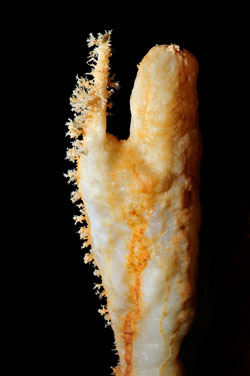
“In 2008, I explored one of the most spectacular caves in France with a group of German cavers. It’s a long water system with several chambers and passages with beautiful sculptural forms. I photographed this ornamented stalagmite, taking care to isolate it from the background.” Technical info: Nikon D700, 60mm f/2.8 Micro-Nikkor, 1/60 sec, ISO 200.
Flashbulbs?
“I still use mostly M3 flashbulbs that were made by Sylvania (Osram), Philips, and others. They are very small, but powerful, with a guide number of 64 at ISO 100 on 28mm lenses and useful for large rooms. I solve the white balance problem with a homemade blue plastic filter placed over the bulb. I use them with or without a reflector, depending on whether I want focused or broad coverage. I can fire them manually, with radio or optical slaves.”
Gedei said manufacturers stopped making the bulbs around 1980, but that he has about 20 packages on hand and can always get more through online auctions. Though he only uses them about twice a year, he said that—in certain lighting situations—the effect they create cannot be duplicated by other sources.
Rounding out his gear is a Sirui Travel tripod. “But, today, because of higher digital ISOs, I often leave the camera tripod home since shutter speeds of around 1/50th are usually enough. It’s different when I’m using an LED light or more complex layouts.”

“The cave is located near Trieste and was discovered during the construction of a road tunnel. During the exploration, I found this group of stalagmites to be especially interesting because of their color contrast and position. The shot was lighted from the left and right sides.” Technical info: Canon 5D Mark II, 16-35mm f/2.8 at 21mm, f/8.0, 1/50 sec, ISO 400.
Future Projects
Gedei thinks the time is ripe for a book. “When I developed the last roll of reversal film in 1995, I wanted to capture the analog period of my caving photography. The result was a self-published book (Caves, Peter Gedei, www.blurb.com). A real book still awaits me and I think it will happen this year or next. The concept is already laid out; there are lots of excellent photographs.” In the meantime, Gedei will add to his impressive list of exhibitions, lectures, publications, and contest successes. In 2009 he took first place out of 8500 entries in a Slovenian national photo competition. He also plans to complete a 3D photographic project he has underway to document the world-famous Slovenian Skocjan Caves—a UNESCO World Heritage site ranked among the most important cave systems in the world.
For more information about Peter Gedei and his work, visit www.petergedei.com.











